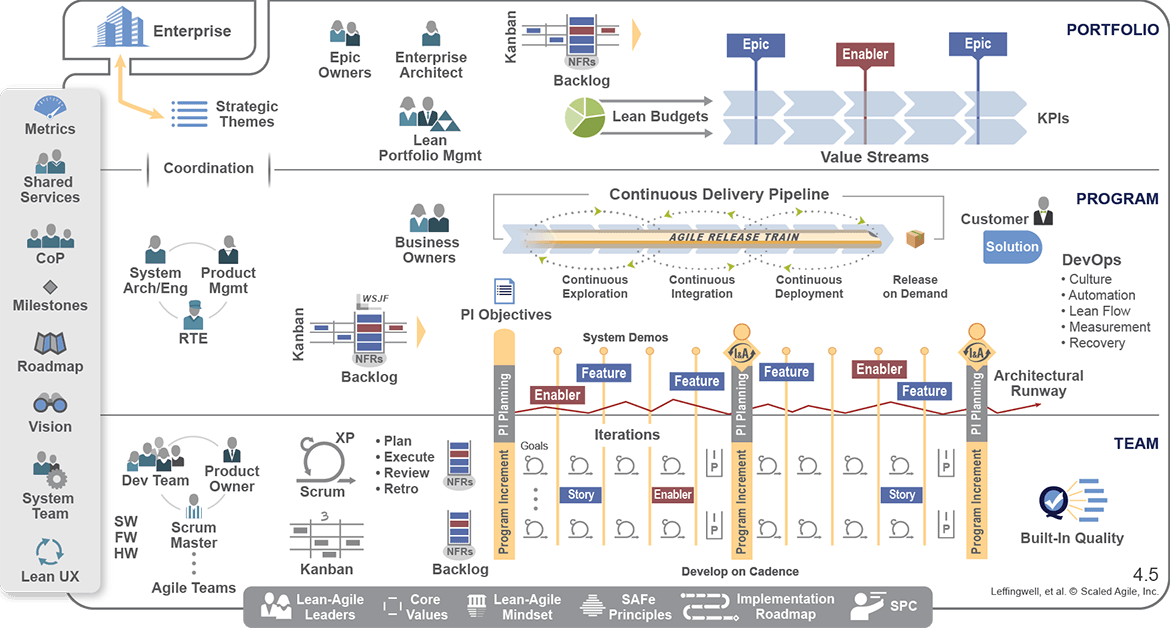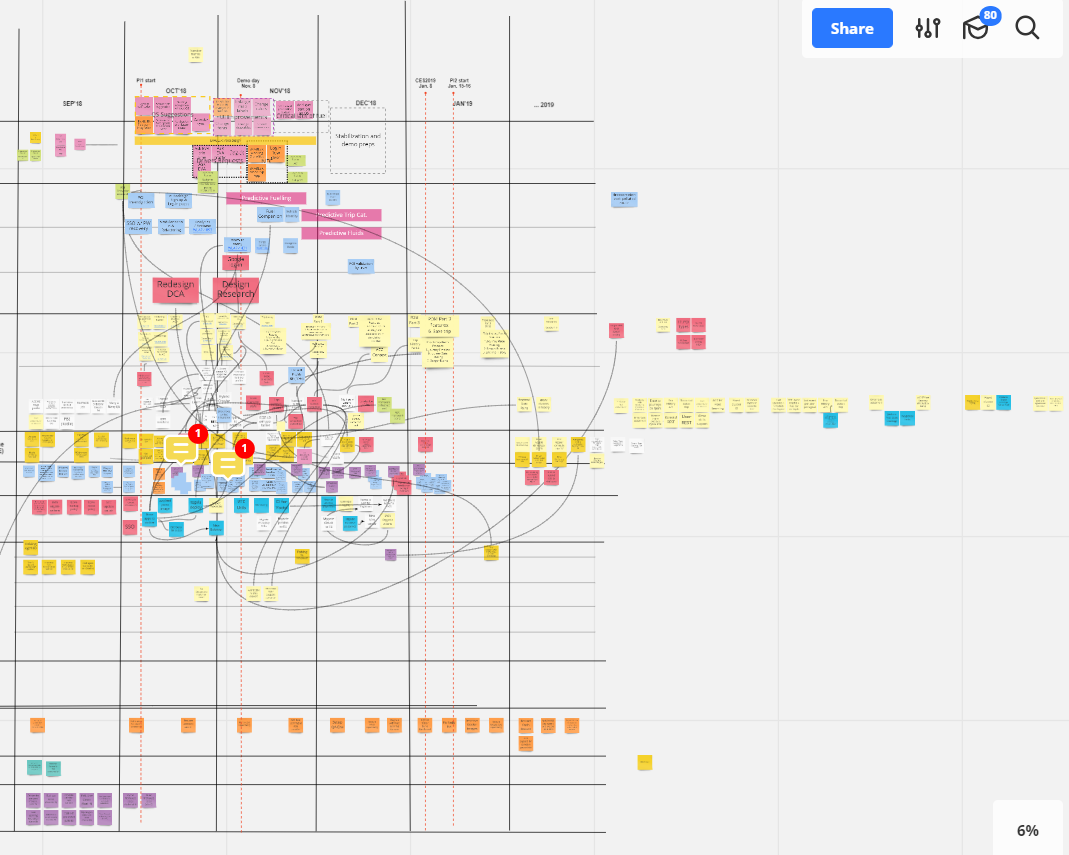Company: CloudMade
Sphere of expertise: AI solutions for automobile industry
Tasks to be solved: run SAFe in the shortest possible time
Background: the company has done the methodology analysis which resulted in taking the decision to utilize SAFe in order to expedite the development process of the core product.
Results:
- E5 experts prepared and tested the first PI planning within a month’s time
- As a part of the preparation for PI session, 70 people were taught the basics of SAFe
- In the first quarter, Essential SAFe was implemented, and the first stage of building Portfolio level was commenced
- The company continues utilizing SAFe, and has held 5E PI planning
CloudMade is an international company specialising in IT products for the automobile industry; is an expert in the area of design, development, and a solution provider based on AI for the automobile industry.
The company’s product is a high-tech one and requires participation of many diverse professionals. Having worked on Agile methodologies (SCRUM и Kanban), at a certain time, the company faced operational management problems. It became obvious that further development and growth of the company will cause new complexities.
The company’s Leadership Team studied varied frameworks on scalability, and having considered all the pros and cons, selected SAFe. In order to run it promptly, swiftly, professionally, and with a predictable outcome, it was decided to engage consultants in order to implement SAFe.
E5 consultants analysed the situation at the company and offered to implement the framework in two stages. The first being to implement a level of the programme – the basic version of Essential SAFe. At this point it was expected to solve the operational management problems of the product as well as management of the developers teams.
The process of Essential SAFe implementation. How Essential SAFe was implemented?
- The approval from the top management (buy-in) had been received, which is one of the crucial aspects of success. Without such an approval, the likelihood of a successful implementation decreases by 40%.
- LACE (Lean-Agile Center of Excellence) team was created which consists of proactive managers taking active part in the process of the implementation and were also change agents within their teams.
- The whole team which comprised of 70 people (Kyiv-based office) was taught the basics of SAFe.
- The preparation for the first planning PI (Program Increment) was held. The preparation itself took almost a month, without having to put a halt to business processes of the company, and with minimal disruption of the teams from the development process, and it comprised of the following stages:
- Identifying the key roles (Product Managers, Product Owners, RTE, System Architect, Scrum Masters) as well as who would perform those roles
- Working with the Product-team on preparing the backlog of the product for the first PI planning
- Synchronising sprints and developing a timeline for planning at the program level
- Preparing the teams and beginning to work with the changes including LAC resistance and criticism assessment.
The first PI planning lasted 2 days with over 70 participants (8 teams). Key people from other countries arrived, such as Product Managers and Product Owners from Germany, Architects form London – without whom no effective planning would be possible. The planning process commenced from working on Program Board which reflected all the dependencies existing in the product at the stage of planning. Having worked on the dependencies, the tasks were split into sprints, and the planning was performed at the level of a team. Every team’s progress was displayed real-time on the main screen at the conference hall. Hence, all the participants of the process (including those who were not able to take part in it in person) could make adjustments while planning instead of running the process of clarification and resynchronising it over and over.
The more detailed description of the classic process of the planning has been provided by us in the DOU article.
After 2 days of PI Planning, We held team retrospectives and received the feedback on the planning process itself, which allowed us to hold the following PI planning in a more efficient way
CloudMade got its first tangible business results even at the stage of conducting the first PI.
- The teams got a better overall vision of the product, and better comprehension of the plans for the nearest quarter. The employees got more engaged in the product.
- The time for feature release (time to market) decreased.
- Transparency became greater: it become clear who oversees what, who does what, and who is supposed to be addressed with a certain type of issues.
- An excellent partnership between various teams was accomplished, for instance, between the management and architects, which used to be problematic due to much workload and distributed locations.
At this point E5 concluded their implementation of the basic version of SAFe. The next step was to implement SAFe Portfolio version. Such a step was a crucial one for CloudMade as of a product company since the validation process of business ideas must be conducted in a thorough and systematic way. Namely it allows to create a level of a portfolio.
Stages of SAFe Portfolio implementation:
-
-
- Creating LPM (Lean Portfolio Management) – teams of product and top managers who define the strategy of product development such as: which ideas are worth working on in more details, and which ones are not as essential for the company in the nearest future. These teams are also in charge of high level prioritisation. We commenced with defining the roles and the people who perform those roles; hosted portfolio meetings on a regular basis. As a result, product teams began to receive regularly all the relevant information and requirements.
- Implementation of the business hypothesis validation cycle with the help of Portfolio Kanban. Presumably, the Head of Marketing says: “I need this specific type of analytics”. However, in order to obtain one in a product, a certain type of cycle has to take place. And so, we started building such a cycle. To begin with, we make a preliminary presentation of the idea for the people in charge of the product, discuss the idea and make the decision on whether we are interested in it or not. The next step is analyzing. We carry out market research and see who else will be keen on the idea other than the Head of Marketing, who is to utilize it, and whether end users will need it; perhaps we do beta testing and customer survey depending on a type of product. The outcome of such a cycle will be the final decision if the product should be invested in.
- Began prioritising based on the WSJF (Weighted Shortest Job First) principle.
-
Conclusion:
- SAFe implementation has been a success at the company due to the following factors:
- Availability of support from the top management
- Insync and well-coordinated work of leaders on impelentation teams
- Well-planned strides in implementation and in adapting the theory to the company’s reality
It allowed to prepare and hold the first planning Program Increment in a short period of time which was followed by company’s working based on a different methodology; the processes of Inspect & Adapt followed. The framework itself allowed the company to solve their tasks in three substantive areas: the product (the vision of the product became clearer, the quality increased); the team (dependencies were resolved, engagement increased); and the general transparency of the processes and interaction.
If you have an interest in E5 consultants’ analysis and implementation of SAFe at your company, write to us at info@e5.ua





